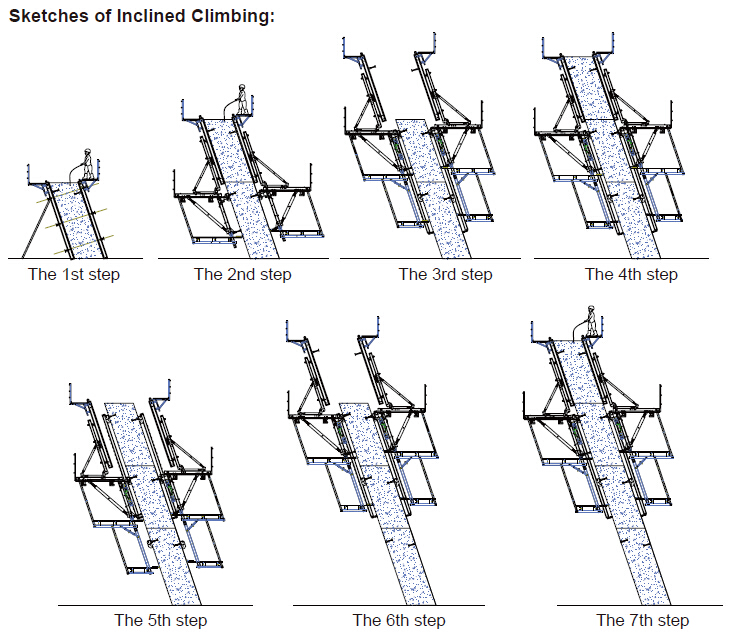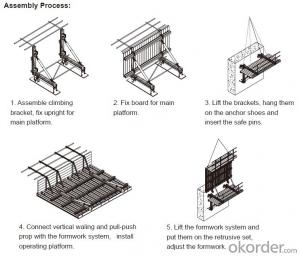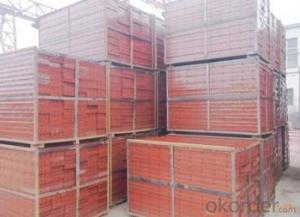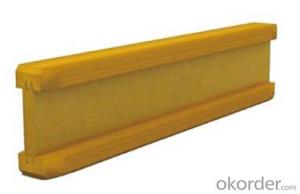Auto-climbing Bracket ACB100 & ACB50 for formwork and scaffolding system
- Loading Port:
- Tianjin
- Payment Terms:
- TT OR LC
- Min Order Qty:
- 50 m²
- Supply Capability:
- 1000 m²/month
OKorder Service Pledge
OKorder Financial Service
You Might Also Like
Auto-climbing Bracket ACB100 & ACB50
The power of the auto-climbing formwork is the hydraulic system, which includes the oil cylinder
and two commutators. The commutators can control the climbing of climbing rail and the bracket.
The steel rail and the bracket can inter-climbing, so the whole system will climb up steadily.
Cranes are not needed during the construction. It’s easy to operate, highly efficient and safe. It’s
the best choice for the construction of high buildings and bridges.
There are mainly two types of standard auto-climbing brackets, ACB-50 and ACB-100, the figure
means the push power of cylinder with unit of KN.
Characteristics:
◆ Perfect load bearing anchor system
Anchor system is the most important supporting part. The system is made of five parts shown
below. Thereinto, tensile bolt, V-climbing cone and washer can be taken out for reusing after the
concrete pouring finished.There are two kinds of anchor systems,A & B. A is matched with single
anchor shoe and B is matched with double anchor shoe.
◆ Crane-independent
Crane-independent forming, striking and climbing speeds up the work procedures on the
construction site and also makes them independent of each other. This means the planned
sequences can be maintained along with guaranteeing high productivity levels. The crane can
therefore be used for other tasks.
Hydraulic system is mainly made of two commutators,
oil cylinder and power distribution system.The
commutators can control the climbing of climbing rail
and bracket.
◆ High bearing capacity and safe
The stable working platforms are able to carry large loads, e.g. the storage of reinforcing steel
for the next climbing section. Generously-sized working platforms, the well thought-out design for
handling very high wind loads and the patented control function of the climbing mechanism are
some of the special details contained within the comprehensive safety concept.
◆ Platforms adjusted to suit the angle of inclination
The horizontal working areas thus created provide safe and comfortable conditions for
reinforcement work, shuttering and striking, concreting and finishing.
◆ The ACB formwork system can climb not only vertically but also slantways, the largest angle is
18 degrees.
◆ The system can climb up wholly or separately. The climbing process is steady, synchronous
and safe.
◆ The bracket will not fall to the ground until the construction is finished, the field will be saved
and the impacting breakage will be reduced (especially the panel).
◆ The system will furnish omnidirectional platform, the construction organizations don’t need to
set up additional operation platform.
◆ The error of structure construction is small and easy to correct.
◆ The climbing speed is fast, the construction course will be quickened.
◆ The formwork can climb itself and cleaning work can be done in the same situs , the used times
of tower crane will be greatly reduced.

- Q: Can steel formwork be used for curved structures?
- Yes, steel formwork can be used for curved structures. Steel is a versatile material that can be easily shaped and molded to form curved structures, making it suitable for creating curved formwork.
- Q: How does steel formwork handle concrete surface blemishes?
- Steel formwork is a popular choice in construction projects because of its durability and strength. It offers several advantages when it comes to dealing with concrete surface blemishes. To begin with, the smooth and rigid surface of steel formwork helps minimize the occurrence of surface blemishes on the concrete. Unlike timber or other formwork materials that may warp or deform easily, steel maintains a consistent and even surface for pouring the concrete. This reduces the chances of imperfections like air pockets, formwork marks, or uneven textures. Furthermore, steel formwork allows for precise control over the concrete pouring process. The panels are manufactured with high precision, ensuring accurate dimensions and alignment. Tight joints and connections between the panels further minimize the likelihood of concrete seepage or leakage, which can cause blemishes such as honeycombing or efflorescence. Moreover, steel formwork is easy to clean and maintain, which helps prevent or handle concrete surface blemishes. The smooth surface allows for easy removal of excess concrete or debris that may accumulate during pouring. This prevents the formation of unwanted blemishes and preserves the quality of the concrete surface. In situations where concrete surface blemishes do occur, steel formwork has the advantage of being reusable. Unlike other formwork materials that may need to be discarded after a single use, steel formwork can be easily cleaned, repaired, and used again for multiple projects. This provides more control over the quality of the formwork, reducing the risk of surface blemishes in subsequent concrete pours. In conclusion, steel formwork effectively handles concrete surface blemishes by providing a smooth and rigid surface, precise control over the pouring process, easy maintenance and cleaning, and reusability. These features contribute to achieving a high-quality concrete surface with minimal blemishes, ensuring an aesthetically pleasing and structurally sound end result.
- Q: What are the typical dimensions of steel formwork panels?
- The typical dimensions of steel formwork panels can vary depending on the specific requirements of the construction project. However, common dimensions for steel formwork panels range from 1.2 meters to 2.4 meters in width and 1.2 meters to 3 meters in height. These dimensions are designed to provide stability and versatility while accommodating various construction needs.
- Q: What are the fire resistance properties of steel formwork?
- Steel formwork is renowned for its exceptional fire resistance. Being a non-combustible material, steel does not burn or contribute to the propagation of fire. Its high melting point confers remarkable resistance to heat and flames. In case of a fire, steel formwork remains intact, ensuring the safety of workers and preventing the fire from spreading to other areas. In addition, steel formwork does not release toxic fumes or smoke when exposed to high temperatures, unlike wood or plastic, which are commonly used in construction. This aspect is crucial as toxic fumes can be harmful and impede evacuation efforts during a fire emergency. Moreover, steel formwork exhibits low thermal conductivity, meaning it does not readily transfer heat. This feature helps confine the heat within the fire zone, curbing its spread to adjacent areas. It also diminishes the risk of structural damage caused by material expansion and contraction due to heat exposure. All in all, the fire-resistant properties of steel formwork render it a dependable choice for construction projects, particularly in locations where fire safety is of utmost importance. Its non-combustible nature, high melting point, absence of toxic fumes, and low thermal conductivity collectively contribute to establishing a secure and safeguarded environment in the face of potential fire hazards.
- Q: What are the common design considerations for steel formwork in seismic areas?
- To ensure the safety and stability of structures in seismic areas, there are several important factors to consider when designing steel formwork. These factors include: 1. Material strength: It is crucial to use steel with high tensile strength and ductility to withstand seismic forces. Utilizing high-strength steel, like Grade 60 or Grade 80, is often necessary to ensure the formwork can endure the lateral forces generated during earthquakes. 2. Connection details: The connections between different components of the steel formwork must be meticulously designed to withstand seismic loads. Employing proper welding or bolting techniques is essential to ensure the connections are strong enough to resist dynamic forces. 3. Reinforcement: To enhance the structural integrity of the formwork, additional reinforcement such as steel bars or mesh may be required. This reinforcement helps distribute seismic forces and prevents the formation of weak points or failure zones. 4. Stiffness and rigidity: The formwork system should be designed to be adequately stiff and rigid, minimizing deformations and preventing excessive movement during earthquakes. This can be achieved by using thicker steel plates or incorporating diagonal bracing elements to increase overall stiffness. 5. Anchorage and support: To prevent shifting or collapsing during seismic events, the formwork needs to be securely anchored to the ground or supporting structure. Incorporating adequate anchorage and support systems, such as anchor bolts or braces, into the design is crucial for formwork stability. 6. Compatibility with other building components: Consideration must be given to the compatibility of the steel formwork with other structural elements, such as concrete walls or columns. Proper coordination and integration with other building components are essential for overall stability and seismic performance. 7. Robustness and redundancy: The formwork design should incorporate features that provide redundancy and robustness, enabling it to withstand unexpected loading conditions or localized damage during earthquakes. This can be achieved by incorporating multiple load paths or redundant structural elements into the formwork system. In summary, the design considerations for steel formwork in seismic areas revolve around ensuring strength, stability, and compatibility with other components. By addressing these factors, engineers can develop robust and resilient formwork designs that contribute to the overall seismic safety of the structure.
- Q: Can steel formwork be used for residential construction projects?
- Yes, steel formwork can be used for residential construction projects. Steel formwork is a versatile and durable option that offers many advantages in residential construction. It provides a strong and stable framework for concrete pouring, ensuring precise and uniform shapes for walls, slabs, and other structural components. Steel formwork is highly reusable, making it a cost-effective choice for residential projects with multiple concrete pours. It can withstand multiple uses and can be easily assembled and disassembled, speeding up the construction process and reducing labor costs. Additionally, steel formwork offers excellent dimensional stability, ensuring that the final structure has accurate dimensions and smooth finishes. It can withstand the pressure of wet concrete, allowing for the construction of high-rise buildings or structures with heavy loads. Moreover, steel formwork allows for flexibility in design, enabling architects and builders to create unique and complex shapes in residential buildings. This versatility makes it suitable for a wide range of architectural styles and designs. While steel formwork may require a higher initial investment compared to other formwork materials, its long lifespan and reusability make it a cost-effective solution in the long run. It also requires less maintenance and repair compared to traditional timber formwork. In conclusion, steel formwork is a suitable choice for residential construction projects due to its strength, durability, reusability, dimensional stability, and flexibility in design. It provides numerous benefits and can help ensure the successful completion of high-quality residential structures.
- Q: How does steel formwork affect the overall energy efficiency of the structure?
- Steel formwork can positively impact the overall energy efficiency of a structure in several ways. Firstly, steel formwork provides a durable and robust framework, ensuring precise construction and reducing the need for additional materials. This results in a more tightly sealed structure, minimizing air infiltration and heat loss. Additionally, steel formwork allows for the efficient installation of insulation materials, improving thermal performance and reducing energy consumption for heating and cooling. Moreover, the reusable nature of steel formwork reduces waste and promotes sustainability, which further enhances the overall energy efficiency of the structure.
- Q: Can steel formwork be used in curved or irregular structures?
- Yes, steel formwork can be used in curved or irregular structures. Steel formwork provides a high level of flexibility and can be easily adjusted to create various shapes and curves. It offers the advantage of being able to withstand high pressure and allows for efficient and precise construction of curved or irregular structures. Steel formwork is particularly suitable for complex architectural designs and structures that require unique shapes, such as curved walls, columns, and beams. Additionally, the durability and strength of steel make it a reliable choice for such applications, ensuring the stability and longevity of the structure.
- Q: Can steel formwork be used for precast concrete cladding panels?
- Yes, steel formwork can be used for precast concrete cladding panels. Steel formwork is a popular choice for creating the molds or forms for precast concrete elements, including cladding panels. Steel formwork offers several advantages such as high strength, durability, and dimensional accuracy. It can be easily fabricated to the desired shape and size, allowing for intricate designs and patterns on the cladding panels. Additionally, steel formwork can be reused multiple times, making it a cost-effective option for large-scale production of precast concrete cladding panels. However, it is important to ensure proper surface treatment to prevent rusting and to maintain the quality and appearance of the cladding panels.
- Q: Can steel formwork be used for sports complex construction projects?
- Yes, steel formwork can be used for sports complex construction projects. Steel formwork is a versatile and durable option for creating temporary molds or structures for casting concrete. Its strength and flexibility make it suitable for various construction projects, including sports complexes. Steel formwork can provide the necessary support and stability required during the construction process, ensuring the efficient and accurate placement of concrete in complex shapes and designs.
Send your message to us
Auto-climbing Bracket ACB100 & ACB50 for formwork and scaffolding system
- Loading Port:
- Tianjin
- Payment Terms:
- TT OR LC
- Min Order Qty:
- 50 m²
- Supply Capability:
- 1000 m²/month
OKorder Service Pledge
OKorder Financial Service
Similar products
Hot products
Hot Searches



















